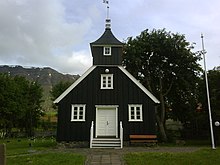Munkaþverá (monastery)
You can help expand this article with text translated from the corresponding article in Icelandic. (January 2022) Click [show] for important translation instructions.
|
65°32′44″N 18°04′58″W / 65.54551°N 18.08268°W

Munkaþverá (Icelandic pronunciation: [ˈmuŋ̊kaˌθvɛːrˌauː]; also transliterated as Munkathvera) was a Benedictine monastery in Eyjafjörður, Iceland. It was established around 1155 and was abolished when the country became Protestant in 1550.
The monastery is best known about its early Abbot Níkulás Bergsson and his famous publication Leiðarvísir og borgarskipan, which was basically a guidebook for pilgrims about the routes from Northern Europe to Rome and Jerusalem. The monastery once was the home of such heroes of saga literature as Einar Þveræingur, Víga-Glúms and Bergur Sokkason. It is believed to be the burial place of Sighvatur Sturluson and his sons who died in the Battle of Örlygsstaðir.
The current church in Munkaþverá was built in 1844. In front of the church, there is a memorial dedicated to Jón Arason, who attended the monastery and did his studies there.
External links
 Media related to Munkaþverá at Wikimedia Commons
Media related to Munkaþverá at Wikimedia Commons- Munkaþverá church
- Benedictine monasteries in Iceland
- Christian monasteries established in the 12th century
- 1155 establishments in Europe
- 1550 disestablishments in Europe
- Churches completed in 1844
- 12th-century establishments in Iceland
- Monasteries dissolved under the Icelandic Reformation
- Christian monastery stubs
- European church stubs
- Icelandic building and structure stubs
